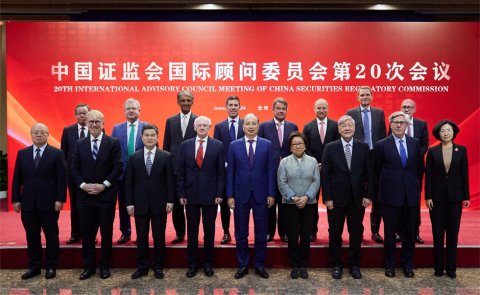In early January, I was in Beijing at the invitation of the China Securities Regulatory Commission to participate in the 20th annual meeting of its International Advisory Council. The IAC consists of market and regulatory experts from around the world who advise China’s markets regulator on how to improve its regulations and open its markets to global institutional participants.
The IAC membership includes the CEOs and chairs of several exchanges, clearing firms, and investment funds. Since becoming a member, I have always been taken by the honest discussions that happen at this forum and this year was no exception.
I first came to China over two decades ago when I was a CFTC Commissioner. Many visas and visits later, I am amazed by the progress of these markets. Globally, 16 of the top 20 commodity futures contracts by volume are listed by Chinese futures exchanges. For agricultural futures contracts, nine out of the top 10 contracts by global volume trade in China.
This success is not surprising given China’s industrial capabilities and its desire to open its financial system to help advance its economy. The CSRC has taken several steps over the last decade to help in this global integration.
For example, four years ago the CSRC lifted the ban on foreign control of domestic brokerages and there are now 20 global investment banks that own a majority or the entirety of a Chinese securities or futures brokerage firm. During this time, the CSRC has also opened 46 domestic futures and options contracts to direct foreign participation.
These are all positive and cumulative developments in the globalization of the Chinese futures markets. Global hedgers seek access to markets across the globe, wherever risk resides – and China is no different. As the second largest economy in the world, there are benefits from the greater integration of China into the global financial system.
But the elephant in the room remains the political uncertainty that hangs over the Chinese markets. FIA is about to publish a survey, conducted on its behalf by Coalition Greenwich, which asked market participants to share their views on a wide range of industry issues, including their views on China's futures markets.
When we asked people working at buyside and sellside firms to identify the biggest obstacles to participating in China's futures markets, regulatory uncertainty was a common theme in their responses.
- 69% of respondents identified Chinese regulatory restrictions
- 65% identified legal uncertainty
- 64% listed the risk of government intervention in the markets
This is a troubling sentiment for these markets. But I’d rather focus on where progress can be made and there are some tangible takeaways that can be done on a regulatory level to make these markets more accessible, and reduce uncertainty, for foreign participants.
The first takeaway is that CSRC and IAC participants remain committed to the goal of expanding foreign participation in China’s markets and bringing greater certainty and guidance to its regulations. The passage of the China Futures and Derivatives Law two years ago was a significant step in this direction, but more can be done.
During the meeting, I discussed FIA’s market survey which revealed that nearly one-third of respondents identified ambiguity in China’s close-out netting laws for futures and derivatives as an impediment to participating in China’s markets. This sounds complicated but the concept is very simple: Intermediaries and market participants want certainty that during a bankruptcy, they will be able to close-out their hedged portfolios on a holistic, net basis, without the risk of a legal challenge.
Why is this important? Because intermediaries carefully manage their clients’ positions in a risk-reducing manner. If a hedged portfolio is broken apart during an insolvency, the risk of the portfolio increases. This results in higher capital charges, increased costs for end users, and a loss of clearing capacity.
The second takeaway was the renewed commitment of the CSRC and IAC to further engagement and dialogue. All relationships are based on trust and, if we’re being honest, this cannot be done over Zoom. This was the IAC’s first in-person meeting since the pandemic, and I found it incredibly productive. I believe the CSRC did too. Not just the official meeting, but the side meetings and casual conversations over dinner where the real conversations sometimes occur. The IAC encouraged the CSRC to do more of these in-person meetings with industry members to learn where further improvements can be made and relationships can be strengthened. Just as important, this dialogue will build trust and make further advancements possible.
Both the global markets and China benefit from the opening of these markets to the world. It makes these markets safer and more accessible to investors and hedgers wherever they may reside. That leads to a more resilient global economy and stable world. And that’s a win for everyone!


